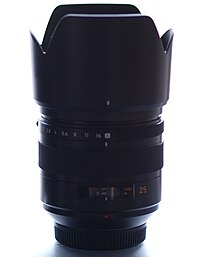 | |
| Maker | Panasonic |
|---|---|
| Lens mount(s) | Four Thirds |
| Technical data | |
| Type | Prime |
| Focus drive | Micromotor |
| Focal length | 25 mm |
| Focal length (35mm equiv.) | 50 mm |
| Aperture (max/min) | f/1.4–16 |
| Close focus distance | 0.38 metres (1.2 ft) |
| Max. magnification | 0.18 |
| Diaphragm blades | 7 |
| Construction | 10 elements in 9 groups |
| Features | |
| Manual focus override | |
| Weather-sealing | |
| Lens-based stabilization | |
| Aperture ring | |
| Physical | |
| Max. length | 75.0 millimetres (2.95 in) |
| Diameter | 77.7 millimetres (3.06 in) |
| Weight | 510 grams (1.12 lb) |
| Filter diameter | 62 mm |
| Accessories | |
| Lens hood | petal shaped hood |
| Angle of view | |
| Diagonal | 47° |
| History | |
| Introduction | 2007 |
The Panasonic Leica D Summilux Asph 25mm F1.4 is an interchangeable camera lens announced by Panasonic on March 7, 2007.
The lens uses 10 elements in 9 groups, arranged as a double Gauss type, with one aspherical, three extra-low dispersion (ED), and one super ED element. It was announced in March 2007, with availability starting that April.[1]
As reviewed in 2010, the lens exhibited little distortion and offered close to maximum resolution wide-open, improving slightly at f/2.[2] Resolution on the frame's edge was weaker, though, due to chromatic aberration and visible coma at maximum aperture.[3]